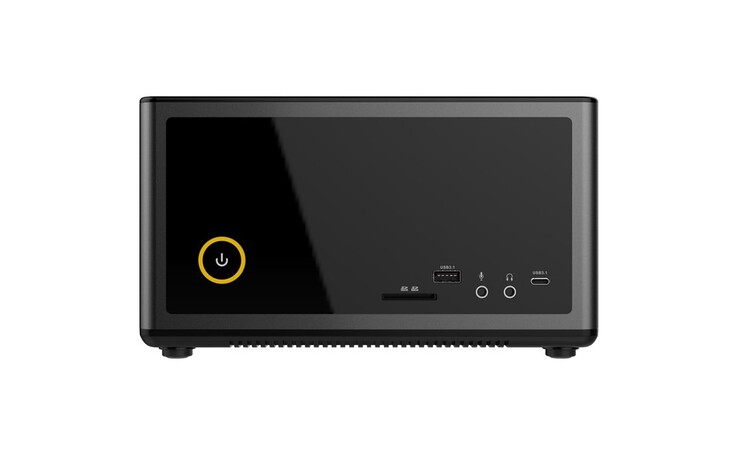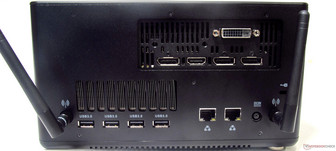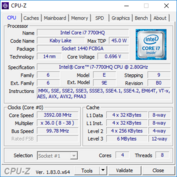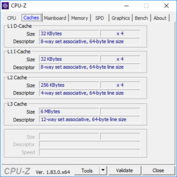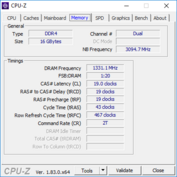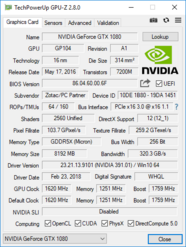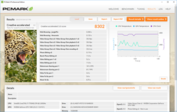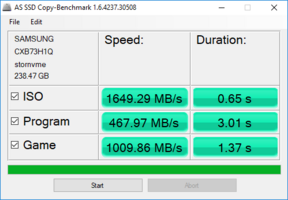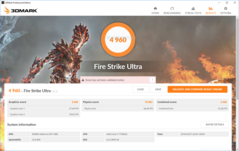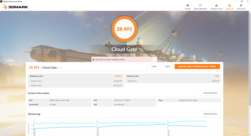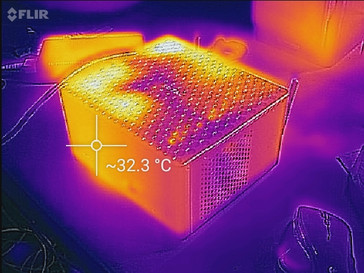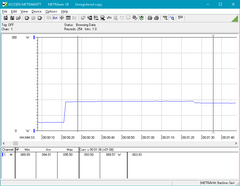Test Zotac ZBOX Magnus EK71080 (i7-7700HQ, GTX 1080) Mini-PC

Wir haben den kleineren Magnus EN51050 Mini-PC letzten September getestet, und es war ein kompakter sowie fähiger Low-End Gaming-PC. CPU- und GPU-Performance waren im Vergleich mit anderen Geräten, die mit vergleichbaren Komponenten ausgestattet sind, allerdings ein wenig enttäuschend. Das lag jedoch an dem begrenzten Platz. Unser heutiges Testgerät, der Magnus EK7180 (in Deutschland EN, bietet jedoch mehr Raum für die Kühlung und die Stromversorgung. In dem größeren Gehäuse befinden sich ein schneller Intel Core i7-7700HQ in Kombination mit der vollwertigen Desktop-GPU Nvidia GeForce GTX 1080 (eine von Zotacs eigenen Modellen). Der Hersteller bietet noch ein weiteres Modell mit der identischen GTX-1080-GPU, aber einem Desktop Intel Core i7-7700 samt einer All-in-One Wasserkühlung an (gegenüber der traditionelleren Luftkühlung unseres Modells). In Deutschland trägt dieses Modell die Bezeichnung EN1080K und kostet 1.849 Euro.
Wie bei allen anderen Zotac ZBOX-Maschinen bekommt man nur einen Barebone-PC. Für rund 1.500 US-Dollar erhält der potenzielle Käufer ein Gehäuse, Netzteil, WLAN-Modul, GPU sowie die CPU. Den Arbeitsspeicher (SODIMM), die Festplatte (entweder M.2-SSD oder 2,5-Zoll-Laufwerk), das Betriebssystem, einen Monitor und Eingabegeräte muss man selbst kaufen. Das sind durchaus Faktoren, die man bei der Preisberechnung der ZBOX beachten sollte. Wir haben das Testgerät mit 16 GB (2x 8 GB) DDR4-2666-RAM (Kingston), eine 256 GB große NVMe-SSD von Samsung (PM961) sowie einer 1 TB großen HDD von HGST (7.200 U/Min) ausgerüstet. Diese Teile haben wir dem Omen X 17 entnommen, der uns von Computer Upgrade King zur Verfügung gestellt wurde. Der EK7180 bietet zudem einen Steckplatz für Intels neuen Optane-Speicher.
Für diesen Test werden wir den Magnus EK7180 mit ähnlich ausgestatteten Gaming-Laptops vergleichen, inklusive dem HP Omen X 17, dem Asus ROG Strix GL702VI, dem Eurocom Tornado F5 Killer Edition, dem Eurocom Sky X4C, dem Schenker XMG U727 (2017) und dem MSI GT75VR. Da man seine eigenen Eingabegeräte und Bildschirme nutzen muss, werden wir diese Testsektionen nicht behandeln.
Gehäuse
Die Seitenwände des EK7180 sind aus Aluminium gefertigt. Die Oberflächen sind matt-schwarz und unempfindlich gegen Fingerabdrücke (obwohl man das System nach dem Zusammenbau wohl nicht oft berühren wird). Sowohl auf der linken als auch der rechten Seite gibt es Belüftungsöffnungen, die einem Wabengitter ähneln. Die kleine Box kann man zwar auch irgendwo verstauen, doch auch auf dem Schreibtisch hinterlässt das System eine gute Figur. Eine einzelne gelbe LED am Power-Button bringt etwas Farbe ins Spiel. Alles in allem also eine dezente schwarze Box mit einem netten Design.
Aufgrund der Größe gibt es keine VESA-Befestigung, allerdings wäre die Box für die meisten Systeme auch zu schwer. Trotz des hohen Gewichts liegt der Schwerpunkt ziemlich tief, was der Stabilität hilft. Die Spaltmaße sind gering und gleichmäßig, und alle Seiten (auch mit den Lüftungsöffnungen) lassen sich auch unter Druck nur minimal eindrücken. Knarzgeräusche gibt es aber nicht.
Im Vergleich zu anderen Mini-PCs ist der EK71080 deutlich größer und schwerer. Intels NUC-Systeme sind dagegen unglaublich kompakt und auch die meisten anderen ZBOX-Modelle von Zotac, die ein ähnliches Gehäuse wie das EN51050 nutzen, sind nur etwa halb so schwer und groß. Allerdings bieten diese Geräte auch nicht die Leistung des EK71080. Als Desktop-PC ist der EK71080 sehr klein und lässt sich fast überall aufstellen.
Ausstattung
Als vollwertiger Desktop-PC mangelt es dem EK71080 nicht an Anschlüssen. Auf der Vorderseite gibt es einen SD-Kartenleser (der die Karte nur halb aufnimmt), die beiden Audioanschlüsse und zwei USB-3.1-Stecker (Gen2, 1x USB-C). An der Rückseite befinden sich 4 USB-3.0-Anschlüsse, zwei LAN-Buchsen und ausreichend Videoausgänge (3x DisplayPort 1.4, HDMI 2.0b, Dual-Link DVI). Der EK71080 kann bis zu 4 Monitore ansteuern.
Sadly, there is no Thunderbolt 3 connection anywhere on the machine, but as it has a plethora of other ports, a powerful desktop GPU, and easily swappable storage, there is less need for Thunderbolt 3 here than on a laptop. The ports are well spaced and leave plenty of room for multiple adjacent connections.
SD-Kartenleser
The performance of the card reader is disappointing. While most gaming laptops manage to hit a minimum of 70 MB/s in our JPG copy test, the EK71080 is barely able to break 40 MB/s (using our Toshiba Exceria USH-II reference card). This is line with the Magnus EN51050 but pales in comparison to even mid-tier gaming notebooks.
| SD Card Reader | |
| average JPG Copy Test (av. of 3 runs) | |
| Eurocom Sky X4C (Toshiba Exceria Pro SDXC 64 GB UHS-II) | |
| SCHENKER XMG U727 2017 (Toshiba Exceria Pro SDXC 64 GB UHS-II) | |
| Eurocom Tornado F5 Killer Edition (Toshiba Exceria Pro SDXC 64 GB UHS-II) | |
| Durchschnitt der Klasse Gaming (19 - 202, n=100, der letzten 2 Jahre) | |
| MSI GT75VR 7RF-012 Titan Pro (Toshiba Exceria Pro SDXC 64 GB UHS-II) | |
| HP Omen X 17-ap0xx (Toshiba Exceria Pro SDXC 64 GB UHS-II) | |
| Asus ROG Strix GL702VI-WB74 | |
| Zotac ZBOX Magnus EN51050 (Toshiba Exceria Pro SDXC 64 GB UHS-II) | |
| Zotac ZBOX Magnus EK71080 (Toshiba Exceria Pro SDXC 64 GB UHS-II) | |
| maximum AS SSD Seq Read Test (1GB) | |
| Eurocom Tornado F5 Killer Edition (Toshiba Exceria Pro SDXC 64 GB UHS-II) | |
| SCHENKER XMG U727 2017 (Toshiba Exceria Pro SDXC 64 GB UHS-II) | |
| Eurocom Sky X4C (Toshiba Exceria Pro SDXC 64 GB UHS-II) | |
| Durchschnitt der Klasse Gaming (25.8 - 269, n=94, der letzten 2 Jahre) | |
| Asus ROG Strix GL702VI-WB74 | |
| MSI GT75VR 7RF-012 Titan Pro (Toshiba Exceria Pro SDXC 64 GB UHS-II) | |
| HP Omen X 17-ap0xx (Toshiba Exceria Pro SDXC 64 GB UHS-II) | |
| Zotac ZBOX Magnus EK71080 (Toshiba Exceria Pro SDXC 64 GB UHS-II) | |
| Zotac ZBOX Magnus EN51050 (Toshiba Exceria Pro SDXC 64 GB UHS-II) | |
Kommunikation
Wifi speeds follow suit with the SD card reader. While connections are stable, they are comparatively slow at 321 Mbit/s and 213 receiving and sending, respectively. This should be adequate for online gaming, but users in need of faster speeds should hardline into one of the two available Ethernet jacks. Keep in mind that these speeds are in line with the Intel 3165 dual-band WiFi card used in the EK71080. Most gaming laptops opt for faster wireless cards and subsequently beat the EK71080 by a country mile; average speeds for gaming laptops land in the mid-500 MBit/s range. We would like to see Zotac use a higher-end wireless NIC in future revisions.
| Networking | |
| iperf3 transmit AX12 | |
| Durchschnitt der Klasse Gaming (885 - 1412, n=4, der letzten 2 Jahre) | |
| Eurocom Sky X4C | |
| HP Omen X 17-ap0xx | |
| MSI GT75VR 7RF-012 Titan Pro | |
| Eurocom Tornado F5 Killer Edition | |
| Zotac ZBOX Magnus EN51050 | |
| Zotac ZBOX Magnus EK71080 | |
| iperf3 receive AX12 | |
| Durchschnitt der Klasse Gaming (881 - 1700, n=4, der letzten 2 Jahre) | |
| MSI GT75VR 7RF-012 Titan Pro | |
| Eurocom Sky X4C | |
| Eurocom Tornado F5 Killer Edition | |
| HP Omen X 17-ap0xx | |
| Zotac ZBOX Magnus EN51050 | |
| Zotac ZBOX Magnus EK71080 | |
Wartung & Garantie
As a barebones desktop, maintenance is incredibly easy compared to most laptops (and some prebuilt desktops). Four thumbscrews that double as feet are all that hold the bottom panel on, and these don't require a tool to unscrew. Once these screws are out, the bottom panel lifts off to show clearly labeled slots for 2 RAM SODIMMS, an M.2 SSD, a 2.5-inch SATA drive, and a dedicated slot for Intel Optane memory. Sadly, the CPU and GPU are a fair bit more difficult to reach. Accessing them will void the warranty. The GPU can be swapped out but the CPU is soldered to the mainboard and cannot be upgraded.
The Zotac ZBOX Magnus EK71080 comes with a standard 2-year warranty.
Leistung
The ZBOX Magnus EK71080 packs some powerful components in such a small body. The star of the show is the desktop-class Nvidia GeForce GTX 1080. The card is one of Zotac's Mini GPUs and is, as of the time of publication, one of only two small-form-factor GTX 1080s (the other being an ITX card from Gigabyte). While we've seen the GTX 1080 in gaming laptops over the past year, the desktop 1080 in our review unit today should boast a slight bump in performance due to better cooling and a subsequent higher thermal limit. The integrated Intel HD Graphics 630 GPU is disabled out of the box, so Optimus is not available.
While the Intel Core i7-7700HQ CPU is also a powerful piece of silicon, the 45 W CPU is designed for use in notebooks. Zotac does offer a SKU with the 65 W Core i7-7700 desktop CPU. Those in need of a high processing punch may want to opt for this model, but the 7700HQ should be more than adequate for gaming and shouldn't present a significant bottleneck for the GTX 1080.
Prozessor
It's interesting that Zotac opted for a CPU designed for laptops. The Intel Core i7-7700HQ is a powerful processor in its own right, but in the world of gaming desktop PCs, the 45 W CPU looks limiting on paper. Indeed, benchmarks reflect this sentiment; the EK71080 falls behind the desktop-class Core i7-7700K and i7-8700K CPUs in Cinebench R15's multi-threaded test by a fair margin. Compared to other 7700HQ-powered devices, however, the EK71080 performs admirably, hitting just under 740 CB in the test (compared to the notebook average of 726 CB for the 7700HQ). There are more powerful CPUs available on the market, but the 7700HQ fares well enough and has the added benefit of improved thermal management, which keeps noise and heat output low. In addition, the CPU outpaces the slower Core i5 CPUs used in the last generation of Magnus gaming mini PCs.
Looping Cinebench R15 sees steady, if reduced, performance. Scores average between 710-720 CB during the benchmark, which is about 4-5% less than a single run. We will examine prolonged performance on the CPU in the Stress Test section below.
For more information on the Intel Core i7-7700HQ, please see our dedicated CPU page here.
| Cinebench R15 | |
| CPU Single 64Bit | |
| Durchschnitt der Klasse Gaming (79.2 - 318, n=234, der letzten 2 Jahre) | |
| SCHENKER XMG U727 2017 | |
| Eurocom Sky X4C | |
| Eurocom Tornado F5 Killer Edition | |
| HP Omen X 17-ap0xx | |
| Zotac ZBOX Magnus EK71080 | |
| MSI GT75VR 7RF-012 Titan Pro | |
| Durchschnittliche Intel Core i7-7700HQ (120 - 162, n=110) | |
| Asus ROG Strix GL702VI-WB74 | |
| Intel Skull Canyon NUC6i7KYK | |
| Zotac ZBOX Magnus EN51050 | |
| CPU Multi 64Bit | |
| Durchschnitt der Klasse Gaming (400 - 5663, n=235, der letzten 2 Jahre) | |
| Eurocom Sky X4C | |
| SCHENKER XMG U727 2017 | |
| HP Omen X 17-ap0xx | |
| MSI GT75VR 7RF-012 Titan Pro | |
| Zotac ZBOX Magnus EK71080 | |
| Durchschnittliche Intel Core i7-7700HQ (603 - 747, n=111) | |
| Asus ROG Strix GL702VI-WB74 | |
| Intel Skull Canyon NUC6i7KYK | |
| Eurocom Tornado F5 Killer Edition | |
| Zotac ZBOX Magnus EN51050 | |
| Cinebench R11.5 | |
| CPU Single 64Bit | |
| Durchschnitt der Klasse Gaming (2.62 - 3.73, n=24, der letzten 2 Jahre) | |
| SCHENKER XMG U727 2017 | |
| Eurocom Sky X4C | |
| Eurocom Tornado F5 Killer Edition | |
| HP Omen X 17-ap0xx | |
| Zotac ZBOX Magnus EK71080 | |
| MSI GT75VR 7RF-012 Titan Pro | |
| Durchschnittliche Intel Core i7-7700HQ (1.36 - 1.84, n=80) | |
| Intel Skull Canyon NUC6i7KYK | |
| Asus ROG Strix GL702VI-WB74 | |
| Zotac ZBOX Magnus EN51050 | |
| CPU Multi 64Bit | |
| Durchschnitt der Klasse Gaming (10.4 - 64.3, n=25, der letzten 2 Jahre) | |
| Eurocom Sky X4C | |
| SCHENKER XMG U727 2017 | |
| HP Omen X 17-ap0xx | |
| MSI GT75VR 7RF-012 Titan Pro | |
| Zotac ZBOX Magnus EK71080 | |
| Asus ROG Strix GL702VI-WB74 | |
| Durchschnittliche Intel Core i7-7700HQ (6.67 - 8.23, n=81) | |
| Intel Skull Canyon NUC6i7KYK | |
| Eurocom Tornado F5 Killer Edition | |
| Zotac ZBOX Magnus EN51050 | |
| Cinebench R10 | |
| Rendering Multiple CPUs 32Bit | |
| Durchschnitt der Klasse Gaming (32456 - 112749, n=25, der letzten 2 Jahre) | |
| Eurocom Sky X4C | |
| Eurocom Tornado F5 Killer Edition | |
| HP Omen X 17-ap0xx | |
| Durchschnittliche Intel Core i7-7700HQ (19409 - 29209, n=51) | |
| Zotac ZBOX Magnus EK71080 | |
| Asus ROG Strix GL702VI-WB74 | |
| Intel Skull Canyon NUC6i7KYK | |
| Zotac ZBOX Magnus EN51050 | |
| Rendering Single 32Bit | |
| Durchschnitt der Klasse Gaming (5719 - 15819, n=25, der letzten 2 Jahre) | |
| Eurocom Sky X4C | |
| Eurocom Tornado F5 Killer Edition | |
| HP Omen X 17-ap0xx | |
| Zotac ZBOX Magnus EK71080 | |
| Durchschnittliche Intel Core i7-7700HQ (5426 - 7647, n=50) | |
| Intel Skull Canyon NUC6i7KYK | |
| Asus ROG Strix GL702VI-WB74 | |
| Zotac ZBOX Magnus EN51050 | |
| wPrime 2.10 - 1024m | |
| Asus ROG Strix GL702VI-WB74 | |
| Durchschnitt der Klasse Gaming (116.8 - 1021, n=14, der letzten 2 Jahre) | |
| Zotac ZBOX Magnus EN51050 | |
| Durchschnittliche Intel Core i7-7700HQ (210 - 379, n=48) | |
| Eurocom Tornado F5 Killer Edition | |
| Intel Skull Canyon NUC6i7KYK | |
| Zotac ZBOX Magnus EK71080 | |
| HP Omen X 17-ap0xx | |
| Eurocom Sky X4C | |
* ... kleinere Werte sind besser
System Performance
System performance is going to vary widely based on the installed components (RAM, hard drive, etc.) chosen by the end user. Our machine, which has 16 GB of DDR4 RAM and a 256 NVMe SSD, performs well. PCMark 10 scores are in line with other GTX 1080-equipped laptops. The Eurocom Sky X4C is far and away better in almost every category, likely due to its more powerful CPU and higher capacity SSD. Nonetheless, the Magnus EK71080 is a responsive machine; we were never left waiting on the system.
| PCMark 8 Home Score Accelerated v2 | 5166 Punkte | |
| PCMark 8 Creative Score Accelerated v2 | 8302 Punkte | |
| PCMark 8 Work Score Accelerated v2 | 5564 Punkte | |
| PCMark 10 Score | 5197 Punkte | |
Hilfe | ||
Massenspeicher
Again, hard drive performance is going to depend heavily on the drive installed by the user. The EK71080 has a slot for a 2.5-inch SATA drive and an M.2 slot that is PCIe NVMe 4x compatible. In other words, fast NVMe SSDs will be able to take advantage of all 4 PCIe lanes for extremely fast speeds. Sadly, there is no option for RAID setups as there is a single SATA slot and a lone M.2 connection. The EK71080 does have a dedicated slot for Intel Optane memory. We did not have any Optane sticks on hand, so we were not able to test these speeds. The Optane slot is not compatible with standard M.2 SSDs.
| Zotac ZBOX Magnus EK71080 Samsung PM961 MZVLW256HEHP | Zotac ZBOX Magnus EN51050 Samsung SSD 960 Pro 512 GB m.2 | HP Omen X 17-ap0xx Samsung PM961 MZVLW256HEHP | MSI GT75VR 7RF-012 Titan Pro 2x Samsung SM961 MZVPW256HEGL NVMe (RAID 0) | Eurocom Sky X4C Samsung SSD 960 Pro 1TB m.2 NVMe | Asus ROG Strix GL702VI-WB74 Samsung PM961 MZVLW256HEHP | Durchschnittliche Samsung PM961 MZVLW256HEHP | |
|---|---|---|---|---|---|---|---|
| CrystalDiskMark 5.2 / 6 | 28% | 6% | 66% | 27% | -9% | -6% | |
| Write 4K | 132.7 | 164.8 24% | 148.8 12% | 165 24% | 158.6 20% | 129.7 -2% | 127.7 ? -4% |
| Read 4K | 44.48 | 54.8 23% | 46.64 5% | 55.9 26% | 55.2 24% | 42.7 -4% | 42.4 ? -5% |
| Write Seq | 1193 | 1956 64% | 1216 2% | 2612 119% | 1568 31% | 972 -19% | 1099 ? -8% |
| Read Seq | 1371 | 1964 43% | 1461 7% | 3377 146% | 1411 3% | 1065 -22% | 1373 ? 0% |
| Write 4K Q32T1 | 398.5 | 424.8 7% | 444 11% | 548 38% | 545 37% | 366.4 -8% | 398 ? 0% |
| Read 4K Q32T1 | 483.5 | 483.8 0% | 535 11% | 625 29% | 661 37% | 449.6 -7% | 403 ? -17% |
| Write Seq Q32T1 | 1202 | 2042 70% | 1210 1% | 2944 145% | 2054 71% | 1113 -7% | 1210 ? 1% |
| Read Seq Q32T1 | 3388 | 3157 -7% | 3450 2% | 3407 1% | 3155 -7% | 3308 -2% | 2984 ? -12% |
Grafikkarte
The Nvidia Geforce GTX 1080 is one of the best GPUs currently on the market, bested only by the GTX 1080 Ti, Titan X, and Titan XP. As such, excellent gaming performance is a given. The Magnus EK71080 has the added benefit of using a desktop-class SKU of the GPU, Zotac's own Mini GTX 1080. The card boasts 2560 CUDA cores clocked at 1620 MHz (boost up to 1759 MHz) and a whopping 8 GB of GDDR5X VRAM on a 256-bit memory bus. The card can support up to 4 independent displays and supports G-Sync enabled monitors.
The EK71080 competes with the best gaming laptops on the market, tying the most powerful laptops in 3DMark Fire Strike. The card also sits about average for desktop versions of the GTX 1080, which should translate into an excellent gaming experience. It's hard to beat the GTX 1080 in the current market, and the EK71080 is proof of that.
For more information about the Nvidia GeForce GTX 1080, please see our dedicated GPU page here.
| 3DMark 11 Performance | 18944 Punkte | |
| 3DMark Ice Storm Standard Score | 132877 Punkte | |
| 3DMark Cloud Gate Standard Score | 28491 Punkte | |
| 3DMark Fire Strike Score | 15651 Punkte | |
| 3DMark Fire Strike Extreme Score | 9035 Punkte | |
| 3DMark Time Spy Score | 6423 Punkte | |
Hilfe | ||
Gaming Performance
It should go without saying that the GTX 1080 provides one of the best gaming experiences currently available. The card chews through any title at FHD and Ultra settings, often churning out over 100 fps in well-optimized titles. Even more difficult games, like Ark: Survival Evolved, run fairly smoothly. Gaming at 4K is also a possibility, although gamers will need to turn settings down to medium/high. The Magnus EK71080 is one of the fastest desktop gaming PCs we've reviewed and should satiate enthusiast gamers for the foreseeable future. A high refresh rate monitor (or two) would be an excellent compliment to the EK71080.
| Rise of the Tomb Raider - 1920x1080 Very High Preset AA:FX AF:16x (nach Ergebnis sortieren) | |
| Zotac ZBOX Magnus EK71080 | |
| Zotac ZBOX Magnus EN51050 | |
| Intel Skull Canyon NUC6i7KYK | |
| HP Omen X 17-ap0xx | |
| Eurocom Sky X4C | |
| Eurocom Tornado F5 Killer Edition | |
| Asus ROG Strix GL702VI-WB74 | |
| Durchschnittliche NVIDIA GeForce GTX 1080 (Desktop) (76.8 - 125, n=6) | |
| Middle-earth: Shadow of War - 1920x1080 Ultra Preset AA:T (nach Ergebnis sortieren) | |
| Zotac ZBOX Magnus EK71080 | |
| Eurocom Sky X4C | |
| Asus ROG Strix GL702VI-WB74 | |
| Durchschnittliche NVIDIA GeForce GTX 1080 (Desktop) (69 - 102, n=3) | |
| F1 2017 - 1920x1080 Ultra High Preset AA:T AF:16x (nach Ergebnis sortieren) | |
| Zotac ZBOX Magnus EK71080 | |
| Zotac ZBOX Magnus EN51050 | |
| HP Omen X 17-ap0xx | |
| Durchschnittliche NVIDIA GeForce GTX 1080 (Desktop) (62 - 120, n=3) | |
| Rocket League - 1920x1080 High Quality AA:High FX (nach Ergebnis sortieren) | |
| Zotac ZBOX Magnus EK71080 | |
| HP Omen X 17-ap0xx | |
| MSI GT75VR 7RF-012 Titan Pro | |
| Durchschnittliche NVIDIA GeForce GTX 1080 (Desktop) (221 - 246, n=2) | |
| Fallout 4 - 1920x1080 Ultra Preset AA:T AF:16x (nach Ergebnis sortieren) | |
| Zotac ZBOX Magnus EK71080 | |
| Zotac ZBOX Magnus EN51050 | |
| HP Omen X 17-ap0xx | |
| Eurocom Sky X4C | |
| Durchschnittliche NVIDIA GeForce GTX 1080 (Desktop) (86.9 - 129, n=3) | |
| The Witcher 3 - 1920x1080 Ultra Graphics & Postprocessing (HBAO+) (nach Ergebnis sortieren) | |
| Zotac ZBOX Magnus EK71080 | |
| Zotac ZBOX Magnus EN51050 | |
| HP Omen X 17-ap0xx | |
| MSI GT75VR 7RF-012 Titan Pro | |
| Eurocom Sky X4C | |
| Eurocom Tornado F5 Killer Edition | |
| SCHENKER XMG U727 2017 | |
| Asus ROG Strix GL702VI-WB74 | |
| Durchschnittliche NVIDIA GeForce GTX 1080 (Desktop) (40.7 - 94, n=5) | |
| Durchschnitt der Klasse Gaming (8.61 - 216, n=226, der letzten 2 Jahre) | |
| Prey - 1920x1080 Very High Preset AA:2TX SM AF:16x (nach Ergebnis sortieren) | |
| Zotac ZBOX Magnus EK71080 | |
| MSI GT75VR 7RF-012 Titan Pro | |
| Eurocom Sky X4C | |
| Durchschnittliche NVIDIA GeForce GTX 1080 (Desktop) (123.2 - 141, n=3) | |
| Ark Survival Evolved - 1920x1080 Epic Preset (100 % Resolution Scale) (nach Ergebnis sortieren) | |
| Zotac ZBOX Magnus EK71080 | |
| Asus ROG Strix GL702VI-WB74 | |
| Durchschnittliche NVIDIA GeForce GTX 1080 (Desktop) (47.2 - 48, n=2) | |
| min. | mittel | hoch | max. | |
| Thief (2014) | 111 | |||
| The Witcher 3 (2015) | 94 | |||
| Batman: Arkham Knight (2015) | 97 | |||
| Metal Gear Solid V (2015) | 60 | |||
| Fallout 4 (2015) | 127 | |||
| Rise of the Tomb Raider (2016) | 110 | |||
| Hitman 2016 (2016) | 75 | |||
| Ashes of the Singularity (2016) | 78 | |||
| Doom (2016) | 130 | |||
| Deus Ex Mankind Divided (2016) | 55 | |||
| Civilization VI (2016) | 66 | |||
| Farming Simulator 17 (2016) | 60 | |||
| Prey (2017) | 140 | |||
| Rocket League (2017) | 221 | |||
| Dirt 4 (2017) | 88 | |||
| F1 2017 (2017) | 110 | |||
| Ark Survival Evolved (2017) | 48 | |||
| Middle-earth: Shadow of War (2017) | 92 |
Stresstest
One of the biggest benefits of the Magnus EK71080's taller chassis lies in heat management. Both the CPU and GPU perform very well under stress. The CPU is able to boost to 3.3-3.4 GHz across all four cores when running Prime95 or FurMark individually and keeps reasonably warm at 80-85° C on average. The GPU also does well when stressed by FurMark, averaging about 1507 MHz at 81° C. Even running Prime95 and FurMark concurrently, which puts the system under an unrealistic amount of stress, doesn't do much to slow the EK71080. The CPU only boosts up to 3.4 GHz, which is about 10% below it's rated boost clock of 3.8 GHz. The machine may be intentionally throttling the CPU to keep temperatures managed.
Real world stress testing, as evidenced by playing The Witcher 3 for an hour, shows how well-tuned the Magnus EK71080 is. The CPU boosts as needed to 3.8 GHz and averages about 3.5 GHz at 80° C. The GPU holds steady at 1772 MHz and keeps (relatively) cool at 81° C. Compared to larger desktop towers, these numbers aren't terribly impressive. Compared to gaming laptops, however, these are excellent results. Some gaming laptops (like the Aorus X9 or Asus GL702VS) struggle to keep their components under 90° C during stress testing and extended gameplay.
During our hour-long test of The Witcher 3, we see an interesting result. Framerates dive from about 100 to 86 before climbing back up to 100. While this follows the day/night progression of the game, we typically do not see dips this drastic. Anecdotally, the dip was not visually noticeable during the test and didn't detract from the experience in any way.
| CPU-Takt (GHz) | GPU-Takt (MHz) | durchschnittliche CPU-Temperatur (°C) | durchschnittliche GPU-Temperatur (°C) | |
| Last Prime95 | 3,3 | 84 | - | - |
| Last FurMark | 3,4 | 80 | 1.507 | 81 |
| Last Prime95 + FurMark | 3,0 | 87 | 1.694 | 71 |
| Last Witcher 3 | 3,5 | 80 | 1.772 | 81 |
Emissionen
Geräuschemissionen
The Magnus EK71080 is a quiet machine. System fans are always active but spin slowly. The resultant noise stays well below 40 dB(A). The low pitch of the fans also blends into background noise well; even though the fans are active, their large size allows for a lower tone that users will have a hard time noticing. Under load, the fans spin up to 47 dB(A) under synthetic load but stay in the low 40s while gaming. Again, their low pitch makes them seem much quieter than the metrics show.
Overall system noise is perceptible only as a low, even hum that can easily be ignored. It should be noted that the EK71080 is much quieter than similar laptops; high-end gaming notebooks typically hit 50-60 dB(A) under full load. Max-Q gaming notebooks hover between 40-50 dB(A), but their fans are typically high-pitched and cut through ambient noise. If users wish to change the fan profile, they will need to jump into the system BIOS to do so; there is no software to control the fans via Windows at present.
There is no audible coil whine.
Lautstärkediagramm
| Idle |
| 38.6 / 38.6 / 39 dB(A) |
| Last |
| 40.6 / 47 dB(A) |
 | ||
30 dB leise 40 dB(A) deutlich hörbar 50 dB(A) störend |
||
min: | ||
| Zotac ZBOX Magnus EK71080 GeForce GTX 1080 (Desktop), i7-7700HQ, Samsung PM961 MZVLW256HEHP | Zotac ZBOX Magnus EN51050 GeForce GTX 1050 Mobile, i5-7500T, Samsung SSD 960 Pro 512 GB m.2 | Intel Skull Canyon NUC6i7KYK Iris Pro Graphics 580, 6770HQ, Samsung SSD 850 EVO m.2 120GB | HP Omen X 17-ap0xx GeForce GTX 1080 Mobile, i7-7820HK, Samsung PM961 MZVLW256HEHP | MSI GT75VR 7RF-012 Titan Pro GeForce GTX 1080 Mobile, i7-7820HK, 2x Samsung SM961 MZVPW256HEGL NVMe (RAID 0) | Eurocom Sky X4C GeForce GTX 1080 Mobile, i7-8700K, Samsung SSD 960 Pro 1TB m.2 NVMe | Eurocom Tornado F5 Killer Edition GeForce GTX 1080 Mobile, i5-7600K, Samsung SSD 960 Evo 250GB m.2 NVMe | SCHENKER XMG U727 2017 GeForce GTX 1080 Mobile, i7-7700K, Samsung SM961 MZVPW256 m.2 PCI-e | Asus ROG Strix GL702VI-WB74 GeForce GTX 1080 Mobile, i7-7700HQ, Samsung PM961 MZVLW256HEHP | |
|---|---|---|---|---|---|---|---|---|---|
| Geräuschentwicklung | 3% | 9% | 6% | -6% | 5% | 1% | -1% | 4% | |
| aus / Umgebung * | 29.9 | 30.7 -3% | 29.5 1% | 28.3 5% | 30 -0% | 28.6 4% | 28.8 4% | 30 -0% | 28.2 6% |
| Idle min * | 38.6 | 37.6 3% | 31.6 18% | 31.5 18% | 33 15% | 28.6 26% | 36.1 6% | 31 20% | 30.6 21% |
| Idle avg * | 38.6 | 37.6 3% | 32.2 17% | 31.6 18% | 34 12% | 28.6 26% | 36.1 6% | 34 12% | 30.6 21% |
| Idle max * | 39 | 37.7 3% | 32.3 17% | 31.6 19% | 38 3% | 31.1 20% | 36.1 7% | 37 5% | 30.6 22% |
| Last avg * | 40.6 | 39.3 3% | 43 -6% | 36.8 9% | 44 -8% | 42.2 -4% | 44.3 -9% | 44 -8% | 38.5 5% |
| Witcher 3 ultra * | 41.7 | 40.6 3% | 48.2 -16% | 56 -34% | 53.8 -29% | 51 -22% | 52 -25% | ||
| Last max * | 47 | 44 6% | 43.2 8% | 52.1 -11% | 62 -32% | 50 -6% | 51.7 -10% | 52 -11% | 57 -21% |
* ... kleinere Werte sind besser
Temperatur
As the Magnus EK71080 is a desktop PC, users shouldn't need to worry too much about exterior temperatures. Still, the Magnus remains fairly cool when under load. The hottest spots lie along the top mesh and rear exhaust vents. So long as users do not place anything on top of or directly behind the unit, heat will be adequately exhausted. The vents along the side act as intakes and should not be blocked either. As such, the unit should be set in its standard orientation (Zotac logo on top) only.
Energieverwaltung
Energieaufnahme
Despite the powerful GPU, the Magnus EK71080 is fairly power efficient. Under synthetic load, the unit draws a maximum of 186 Watts. Even when pushed to its limit during intense gameplay, the unit never pulls more than 260 Watts, which is well under the 330 W rating of the included power supply. The 45 Watt Core i7-7700HQ may have a hand to play in the comparatively frugal power consumption.
It should be noted that while running Prime95 and FurMark together, power draw is erratic and spikes at 292 Watts. While this is still within acceptable limits, these levels are a bit concerning. However, we were only able to achieve this while stressing the machine; during normal use, the unit shouldn't be subjected to loads similar to this, even while gaming.
| Aus / Standby | |
| Idle | |
| Last |
|
Legende:
min: Derzeit nutzen wir das Metrahit Energy, ein professionelles TRMS Leistungs-Multimeter und PQ Analysator, für unsere Messungen. Mehr Details zu dem Messgerät finden Sie hier. Alle unsere Testmethoden beschreiben wir in diesem Artikel. | |
| Zotac ZBOX Magnus EK71080 i7-7700HQ, GeForce GTX 1080 (Desktop), Samsung PM961 MZVLW256HEHP, , x, 0.00 | Zotac ZBOX Magnus EN51050 i5-7500T, GeForce GTX 1050 Mobile, Samsung SSD 960 Pro 512 GB m.2, , x, | Intel Skull Canyon NUC6i7KYK 6770HQ, Iris Pro Graphics 580, Samsung SSD 850 EVO m.2 120GB, , x, 0.00 | HP Omen X 17-ap0xx i7-7820HK, GeForce GTX 1080 Mobile, Samsung PM961 MZVLW256HEHP, IPS, 1920x1080, 17.30 | MSI GT75VR 7RF-012 Titan Pro i7-7820HK, GeForce GTX 1080 Mobile, 2x Samsung SM961 MZVPW256HEGL NVMe (RAID 0), TN LED, 1920x1080, 17.30 | Eurocom Sky X4C i7-8700K, GeForce GTX 1080 Mobile, Samsung SSD 960 Pro 1TB m.2 NVMe, IPS, 3840x2160, 15.60 | Eurocom Tornado F5 Killer Edition i5-7600K, GeForce GTX 1080 Mobile, Samsung SSD 960 Evo 250GB m.2 NVMe, IPS, 3840x2160, 15.60 | SCHENKER XMG U727 2017 i7-7700K, GeForce GTX 1080 Mobile, Samsung SM961 MZVPW256 m.2 PCI-e, AHVA, 3840x2160, 17.30 | Asus ROG Strix GL702VI-WB74 i7-7700HQ, GeForce GTX 1080 Mobile, Samsung PM961 MZVLW256HEHP, IPS, 1920x1080, 17.30 | |
|---|---|---|---|---|---|---|---|---|---|
| Stromverbrauch | 28% | 49% | 7% | -39% | -15% | -33% | -49% | 15% | |
| Idle min * | 27.1 | 21.1 22% | 14.8 45% | 21.6 20% | 34 -25% | 30.2 -11% | 28.4 -5% | 32 -18% | 19.8 27% |
| Idle avg * | 27.4 | 22.1 19% | 15.7 43% | 26.4 4% | 41 -50% | 34.7 -27% | 32 -17% | 43 -57% | 25.2 8% |
| Idle max * | 28.8 | 26.6 8% | 15.8 45% | 26.6 8% | 50 -74% | 37.8 -31% | 33.5 -16% | 51 -77% | 25.9 10% |
| Last avg * | 100.4 | 77.5 23% | 62.7 38% | 95.6 5% | 106 -6% | 130.3 -30% | 190.9 -90% | 138 -37% | 84.1 16% |
| Witcher 3 ultra * | 243.1 | 92.4 62% | 221.7 9% | 257 -6% | 172.2 29% | 279 -15% | 198.6 18% | ||
| Last max * | 186.7 | 121.7 35% | 48.5 74% | 199.6 -7% | 320 -71% | 217.7 -17% | 259.4 -39% | 350 -87% | 171.1 8% |
* ... kleinere Werte sind besser
Pro
Contra
Fazit
Any way you cut it, the Zotac ZBOX Magnus EK71080 is a marvel of engineering. Compared to high-end gaming notebooks, the Magnus EK71080 is just as powerful (if not more so) while remaining cooler and quieter. Maintenance and port selection is also inherently superior to notebooks, and the additional support for Intel Optane memory is icing on the cake. Considering the small size, the gaming performance of the EK71080 is impressive, as is the low fan noise.
Of course, the EK71080 is much larger than other ZBOX desktops and lacks the portability of a gaming laptop. The Magnus EK71080 is also fairly expensive; in addition to the $1500 price tag of the base unit, users will need to provide their own RAM, storage, OS, and peripherals. All of these are included with a laptop. Further, $1500 is a lot to ask for a gaming desktop that uses a lower-powered laptop CPU. Potential buyers will have to shell out $400 more to get a desktop-class processor and liquid cooling, and even then, the processor is locked. On top of all this, it is cheaper to sacrifice the specialized chassis and build a custom desktop.
At least, it was cheaper to build a desktop from scratch. Current GPU prices make the EK71080 much more attractive. Due to the current cryptocurrency mining craze, prices for high-end GPUs like the GTX 1080 have skyrocketed. At the time of this writing, the average price for the GTX 1080 is about USD $850-900, which is 60% of the price of the Magnus EK71080. Even if you can afford the exorbitant price, finding a GTX 1080 is almost impossible; retailers have constantly been sold out.
Given the bizarre pricing of GPUs at present, purchasing the EK71080 is a more compelling option. The compact form factor is more of a nicety and less of a selling point in that regard.
A year ago, the Magnus EK71080 would have been a hard sell due to its high price point. Building a desktop from scratch would have cost significantly less. However, due to the scarcity and inflated pricing of high-end GPUs, the Magnus EK71080 may be a good buy for enthusiasts that want one of the most powerful graphics cards now. Considering that gaming laptops with similar components run about $2500-3000 compared to the EK71080's $1500 tag, users may find more value in giving up the portability and buying the necessary components.


 Deutsch
Deutsch English
English Español
Español Français
Français Italiano
Italiano Nederlands
Nederlands Polski
Polski Português
Português Русский
Русский Türkçe
Türkçe Svenska
Svenska Chinese
Chinese Magyar
Magyar